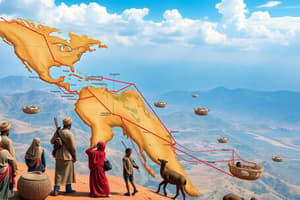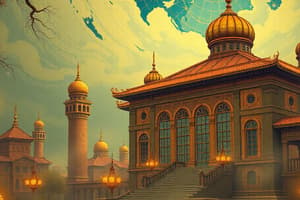Podcast
Questions and Answers
What does cultural hybridization primarily involve?
What does cultural hybridization primarily involve?
- The preservation of distinct cultural differences
- The rejection of external cultural influences
- The uniform adoption of a single global culture
- The mixing of cultures and integration of global and local (correct)
Cultural differentialism suggests that cultures become more alike over time.
Cultural differentialism suggests that cultures become more alike over time.
False (B)
Name one factor that contributes to the emergence of globalization according to Nayan Chanda.
Name one factor that contributes to the emergence of globalization according to Nayan Chanda.
basic human needs
Economic globalization refers to the increasing __________ of world economies.
Economic globalization refers to the increasing __________ of world economies.
Match the following terms with their descriptions:
Match the following terms with their descriptions:
Which event is NOT associated with the historical origins of globalization?
Which event is NOT associated with the historical origins of globalization?
What is the primary function of international financial institutions (IFIs)?
What is the primary function of international financial institutions (IFIs)?
The International Monetary Fund (IMF) has 200 member countries.
The International Monetary Fund (IMF) has 200 member countries.
What era is typically regarded as the heyday of European imperialism?
What era is typically regarded as the heyday of European imperialism?
Transnational corporations engage in value-adding activities in only one country.
Transnational corporations engage in value-adding activities in only one country.
What term describes countries that demand goods and services in the modern world system?
What term describes countries that demand goods and services in the modern world system?
The ________ is a major driver of economic globalization through advocacy networks.
The ________ is a major driver of economic globalization through advocacy networks.
Match the types of states to their characteristics:
Match the types of states to their characteristics:
Which organizations are critical for developing and pushing for neoliberal policies among countries?
Which organizations are critical for developing and pushing for neoliberal policies among countries?
Multinational corporations can operate 24 hours a day due to their global network of locations.
Multinational corporations can operate 24 hours a day due to their global network of locations.
Name one example of a multinational company.
Name one example of a multinational company.
What was one of the main focuses of the Spice Routes?
What was one of the main focuses of the Spice Routes?
The Iron Curtain fell in 1989, marking the beginning of globalization as a truly global phenomenon.
The Iron Curtain fell in 1989, marking the beginning of globalization as a truly global phenomenon.
Name one significant food item introduced to Europe during the Age of Discovery.
Name one significant food item introduced to Europe during the Age of Discovery.
What is a characteristic of the global interstate system?
What is a characteristic of the global interstate system?
The _______ primarily involved European explorers connecting the East and West during the 15th to 18th centuries.
The _______ primarily involved European explorers connecting the East and West during the 15th to 18th centuries.
Global politics is only influenced by local context.
Global politics is only influenced by local context.
Who governs globalization through its 192 member countries?
Who governs globalization through its 192 member countries?
Which invention contributed to the first wave of globalization in the 19th century?
Which invention contributed to the first wave of globalization in the 19th century?
Match the waves of globalization with their primary features:
Match the waves of globalization with their primary features:
The _____ monitors the stability of the international monetary system.
The _____ monitors the stability of the international monetary system.
Economic inequality is one of the positive outcomes of globalization.
Economic inequality is one of the positive outcomes of globalization.
Match the following organizations with their primary functions:
Match the following organizations with their primary functions:
What is meant by the term 'homogeneity' in the context of globalization?
What is meant by the term 'homogeneity' in the context of globalization?
What is one disadvantage of globalization mentioned?
What is one disadvantage of globalization mentioned?
The World Trade Organization ensures a smooth flow of trade among countries.
The World Trade Organization ensures a smooth flow of trade among countries.
Name an organization responsible for providing support to workers and addressing labor problems.
Name an organization responsible for providing support to workers and addressing labor problems.
Flashcards
International Financial Institutions (IFIs)
International Financial Institutions (IFIs)
Financial institutions operating on an international level.
Transnational Corporations
Transnational Corporations
Enterprises engaging in activities across multiple countries.
G8 and G20
G8 and G20
Groups of nations discussing global economic and political issues.
Core States
Core States
Signup and view all the flashcards
Peripheral States
Peripheral States
Signup and view all the flashcards
Multinational Companies (MNCs)
Multinational Companies (MNCs)
Signup and view all the flashcards
Global Civil Society
Global Civil Society
Signup and view all the flashcards
Economic Globalization Example
Economic Globalization Example
Signup and view all the flashcards
Heterogeneity
Heterogeneity
Signup and view all the flashcards
Cultural Differentialism
Cultural Differentialism
Signup and view all the flashcards
Cultural Hybridization
Cultural Hybridization
Signup and view all the flashcards
Cultural Convergence
Cultural Convergence
Signup and view all the flashcards
Economic Globalization
Economic Globalization
Signup and view all the flashcards
Global Economy
Global Economy
Signup and view all the flashcards
International Monetary Fund (IMF)
International Monetary Fund (IMF)
Signup and view all the flashcards
Globalization Cycles
Globalization Cycles
Signup and view all the flashcards
Silk Roads
Silk Roads
Signup and view all the flashcards
Spice Routes
Spice Routes
Signup and view all the flashcards
Age of Discovery
Age of Discovery
Signup and view all the flashcards
First Wave of Globalization
First Wave of Globalization
Signup and view all the flashcards
Iron Curtain
Iron Curtain
Signup and view all the flashcards
Globalization 4.0
Globalization 4.0
Signup and view all the flashcards
Negative Globalization
Negative Globalization
Signup and view all the flashcards
Homogeneity
Homogeneity
Signup and view all the flashcards
Global Interstate System
Global Interstate System
Signup and view all the flashcards
Advantages of Globalization
Advantages of Globalization
Signup and view all the flashcards
Disadvantages of Globalization
Disadvantages of Globalization
Signup and view all the flashcards
United Nations (UN)
United Nations (UN)
Signup and view all the flashcards
World Bank
World Bank
Signup and view all the flashcards
World Trade Organization (WTO)
World Trade Organization (WTO)
Signup and view all the flashcards
World Health Organization (WHO)
World Health Organization (WHO)
Signup and view all the flashcards
Study Notes
History of Globalization
- Globalization is a long-term, cyclical process.
- Early forms: Silk Roads (1st century BC – 5th century AD and 13th–14th centuries AD), connecting China and Eurasia (Rome) using silk
- Spice Routes (7th–15th centuries): Primarily sea-based trade focused on spices by Islamic traders, connected to the Silk Road.
- Age of Discovery (15th–18th centuries): European explorers connected East and West, accidentally discovering the Americas. Potatoes, tomatoes, coffee, and chocolate were introduced to Europe.
- First Wave of Globalization (19th century - 1914): Great Britain dominated geographically and technologically, steam engine and the reefer ship (1870s) impacted Argentina and Uruguay.
- Negative aspects of the First Wave: Most European nations colonized Africa, and by the early 20th century, only Ethiopia remained independent; large countries like India, China, Mexico, or Japan had difficulty adapting to industrial and global trends.
- Second and Third Waves of Globalization: End of World War 2 marked a new beginning for the global economy. The USA leadership and technologies of the second industrial revolution, led to global trade resurgence.
- Iron Curtain (divided the world into spheres of influence): 1989 - Fall of the Iron Curtain, globalization became truly global.
- Soviet Union collapse and WTO promoted free trade agreements for nations worldwide.
- Globalization 4.0: The digital economy is enabled by AI but threatened by cyberattacks. The global cyber world is now a frontier.
Theories on the Origins of Globalization
- Hardwired: According to Nayan Chanda, globalization is driven by basic human needs.
- Cycles: Globalization is a long-term, cyclical process.
- Epoch: Globalization of religion (4th to 7th centuries), European colonial conquests (late 15th century), Intra-European wars (late 18th to early 19th centuries), Heyday of European Imperialism (mid-19th century to 1918), Post-World War II period, Post-Cold War period.
- Events: Specific events are also considered parts of globalization. (e.g., Roman conquests, Christopher Columbus, internet founding)
Broader, More Recent Changes
- Emergence of the USA as a global power (post-World War II).
- Emergence of multinational corporations (MNCs).
- Demise of the Soviet Union, end of the Cold War.
Structure of Globalization
- The Global Economy:
- Economic Globalization: Increasing interdependence of global economies.
- Global Economy: Economies of nations are becoming more interconnected.
- International Monetary Fund (IMF): International organization of 183 member countries that are involved in financial institutions operating on an international level.
- Transnational Corporations: Enterprises that engage in multiple countries.
- G8 and G20: Groups of nations serving as advisory organizations to discuss global economic and political challenges.
- Global Civil Society: Protest and seek alternatives.
Factors Pushing for Economic Globalization
- International Economic Organizations (e.g., IMF, World Bank, OECD): Crucial for developing and promoting neoliberal policies between countries
- Multinational Companies (MNCS): Main drivers of economic globalization (McDonald's, Toyota, Ford)
Examples of How Economic Globalization Works
- Multinational corporations operate globally with satellite offices and branches, staying open 24/7 to serve customers around the world.
- Some automobiles import parts from countries to be assembled, for example in United States, thus engaging in global trade.
The Global Interstate System:
- A system of unequal, competing states where no single state can control all others.
- States interact through shifting alliances and wars.
- Changes in relative power of states upset alliances and restructure the global balance of power.
Advantages and Disadvantages of Globalization
- Advantages: world becomes more interconnected through politics, local and national policies consider global realities.
- Disadvantages: local social and environmental well-being can be sacrificed in favor of globalization (examples: converting farmlands to factories).
Who Governs Globalization?
- United Nations: Facilitates global governance, 192 member countries.
- Regional Commissions (examples: Economic Commission for Africa, Economic Commission for Europe): Groups of officials from different countries responsible for making laws and standards related to economic and social development.
- World Bank: Provides loans to middle-income countries and private sectors in developing countries to improve economies and create markets.
- IMF: Monitors global economy, lends to countries, and offers advisory services.
- WTO: Regulates international trade, provides forums for trade agreements among countries and regions.
- OECD: Promotes economic progress through comparing policy experiences and finding good practices in economic policies among its member countries.
- Others: WHO (focus on medicines and vaccines), ILO (labour standards), and UNESCO (peace by promoting education, scientific, and cultural programs).
Studying That Suits You
Use AI to generate personalized quizzes and flashcards to suit your learning preferences.




